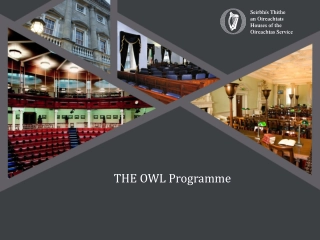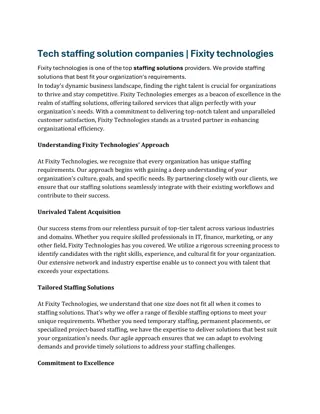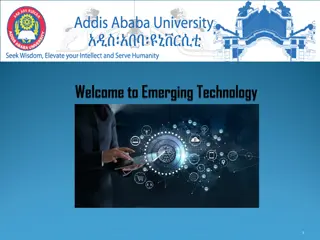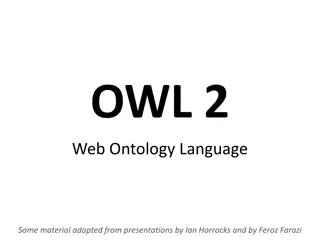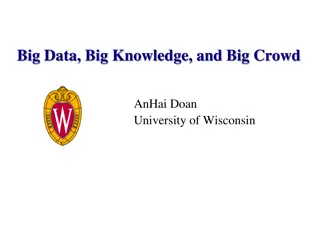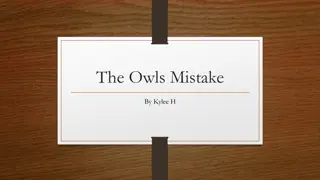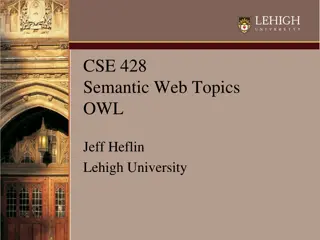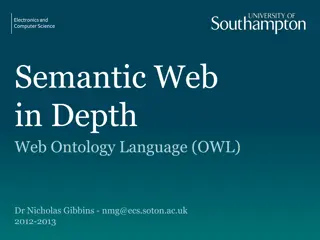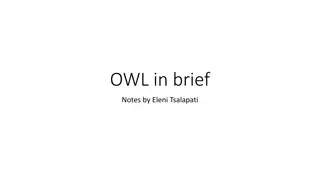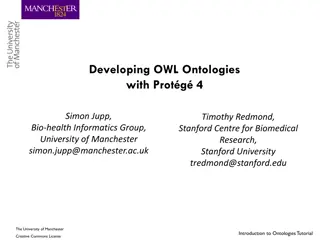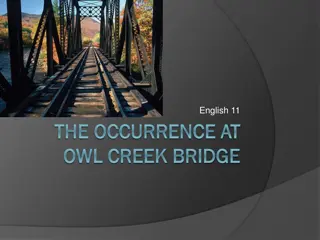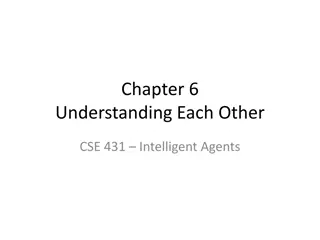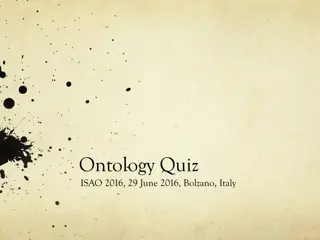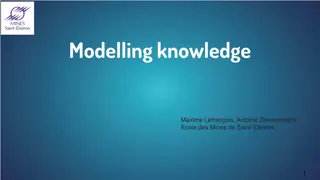Introduction to OWL 2 Knowledge Technologies
Explore the basics of OWL 2, the Web Ontology Language, through a presentation by Manolis Koubarakis. Learn about OWL 2's structural specification, functional syntax, semantics, and profiles. Delve into the terminology of OWL 2, understanding individuals, classes, properties, expressions, and axioms. Discover how OWL 2 is used to represent knowledge on the web, building upon concepts from description logics.
Download Presentation

Please find below an Image/Link to download the presentation.
The content on the website is provided AS IS for your information and personal use only. It may not be sold, licensed, or shared on other websites without obtaining consent from the author.If you encounter any issues during the download, it is possible that the publisher has removed the file from their server.
You are allowed to download the files provided on this website for personal or commercial use, subject to the condition that they are used lawfully. All files are the property of their respective owners.
The content on the website is provided AS IS for your information and personal use only. It may not be sold, licensed, or shared on other websites without obtaining consent from the author.
E N D
Presentation Transcript
An Introduction to OWL 2 Knowledge Technologies Manolis Koubarakis 1
Acknowledgement This presentation is based on the OWL 2 Web Ontology Language Structural Specification and Functional-Style Syntax available at http://www.w3.org/TR/owl2- syntax/ Much of the material in this presentation is verbatim from the above specification. Knowledge Technologies Manolis Koubarakis 2
Outline Features of OWL 2 Structural Specification Functional Syntax Other Syntaxes Examples Semantics of OWL 2 OWL 2 Profiles Knowledge Technologies Manolis Koubarakis 3
The Semantic Web Layer Cake Knowledge Technologies Manolis Koubarakis 4
OWL 2 Basics OWL 2 is the current version of the Web Ontology Language and a W3C recommendation as of October 2009. The previous version of OWL (OWL 1) became a W3C recommendation in 2004. All W3C documents about OWL 2 can be found at http://www.w3.org/TR/2009/REC-owl2- overview-20091027/ . Knowledge Technologies Manolis Koubarakis 5
The Structure of OWL 2 Knowledge Technologies Manolis Koubarakis 6
OWL 2 Basics (contd) OWL 2 is a language for writing ontologies for the Web. It is based on well-known concepts and results from description logics. Like DLs, OWL 2 is a language for representing knowledge about things, groups of things, and relations between things. Knowledge Technologies Manolis Koubarakis 7
OWL 2 Terminology The things or objects about which knowledge is represented (e.g., John, Mary) are called individuals. Groups of things (e.g., female) are called classes. Relations between things (e.g., married) are called properties. Individuals, classes and properties are called entities. Knowledge Technologies Manolis Koubarakis 8
OWL 2 Terminology (contd) As in DLs, entities can be combined using constructors to form complex descriptions called expressions. To represent knowledge in OWL (like in any other KR language), we make statements. These statements are called axioms. Knowledge Technologies Manolis Koubarakis 9
Annotations Entities, expressions and axioms form the logical part of OWL 2. They can be given a precise semantics and inferences can be drawn from them. In addition, entities, axioms, and ontologies can be annotated. Example: A class can be given a human-readable label that provides a more descriptive name for the class. Annotations have no effect on the logical aspects of an ontology. For the purposes of the OWL 2 semantics, annotations are treated as not being present. Knowledge Technologies Manolis Koubarakis 10
IRIs Ontologies and their elements are identified using International Resource Identifiers (IRIs). In OWL 2, an IRI can be written in full or it can be abbreviated as prefix:lname as in XML qualified names where prefix is a namespace and lname is the local name with respect to the namespace. Knowledge Technologies Manolis Koubarakis 11
The Structure of an Ontology Knowledge Technologies Manolis Koubarakis 12
Ontology IRI and Version IRIs An ontology may have an ontology IRI, which is used to identify it. If an ontology has an ontology IRI, the ontology may additionally have a version IRI, which is used to identify the version of the ontology. The version IRI may, but need not be equal to the ontology IRI. An ontology series is identified using an ontology IRI, and each version in the series is assigned a different version IRI. Only one version of the ontology is the current one. Example: Ontology IRI: <http://www.example.com/my> Version IRIs: <http://www.example.com/my/1.0>, <http://www.example.com/my/2.0>, An ontology without an ontology IRI must not contain a version IRI. Ontology IRIs and version IRIs should satisfy various uniqueness constraints that OWL 2 tools should check, for detecting possible problems. Knowledge Technologies Manolis Koubarakis 13
Ontology Document Each ontology is associated with an ontology document which physically contains the ontology stored in a particular way (e.g., a text file). An ontology document should be accessible via the IRIs determined by the rules defined in the W3C specification. Example: The document of the current version of an ontology should always be accessible via the ontology IRI and the current version IRI. Knowledge Technologies Manolis Koubarakis 14
Imports An OWL 2 ontology can import (directly or indirectly) other ontologies in order to gain access to their entities, expressions and axioms, thus providing the basic facility for ontology modularization. Example: an ontology of sensors can import a geospatial ontology to specify the location of sensors. Knowledge Technologies Manolis Koubarakis 15
OWL 2 Syntaxes The Functional-Style syntax. This syntax is designed to be easier for specification purposes and to provide a foundation for the implementation of OWL 2 tools such as APIs and reasoners. This is the syntax we will use in this presentation. The RDF/XML syntax: this is just RDF/XML, with a particular translation for the OWL constructs. Here one can use other popular syntaxes for RDF, e.g., Turtle syntax. The Manchester syntax: this is a frame-based syntax that is designed to be easier for users to read. The OWL XML syntax: this is an XML syntax for OWL defined by an XML schema. OWL Syntax Converter: http://owl.cs.manchester.ac.uk/tools/webapps/owl-syntax-converter/ Knowledge Technologies Manolis Koubarakis 16
BNF Grammar for the Functional Syntax of OWL 2 ontologyDocument := { prefixDeclaration } Ontology prefixDeclaration := 'Prefix' '(' prefixName :=' fullIRI ')' Ontology := 'Ontology' '(' [ ontologyIRI [ versionIRI ] ] directlyImportsDocuments ontologyAnnotations axioms ')' ontologyIRI := IRI versionIRI := IRI directlyImportsDocuments := { 'Import' '(' IRI ')' } axioms := { Axiom } Knowledge Technologies Manolis Koubarakis 17
Example Prefix(ex:=<http://www.example.com/ontology1#>) Prefix(owl:=<http://www.w3.org/2002/07/owl#>) Ontology(<http://www.example.com/ontology1> Import(<http://www.example.com/ontology2>) Annotation(rdfs:label "An example ontology") SubClassOf(ex:Person owl:Thing) SubClassOf(ex:Male ex:Person) SubClassOf(ex:Female ex:Person) ) Knowledge Technologies Manolis Koubarakis 18
Things One Can Define in OWL 2 Knowledge Technologies Manolis Koubarakis 19
Classes Classes (e.g., a:Female) represent sets of individuals. Built-in classes: owl:Thing, which represents the set of all individuals. owl:Nothing, which represents the empty set. Knowledge Technologies Manolis Koubarakis 20
Things One Can Define in OWL 2 (cont d) Knowledge Technologies Manolis Koubarakis 21
Object Properties Object properties (e.g., a:parentOf) connect pairs of individuals. Built-in object properties: owl:topObjectProperty, which connects all possible pairs of individuals. owl:bottomObjectProperty, which does not connect any pair of individuals. Knowledge Technologies Manolis Koubarakis 22
Object Property Expressions Object properties can be used to form object property expressions. Knowledge Technologies Manolis Koubarakis 23
Inverse Object Property Expressions An inverse object property expression ObjectInverseOf(P) connects an individual I1 with I2 if and only if the object property P connects I2 with I1. P I2 I1 ObjectInverseOf(P) Example: If an ontology contains the axiom ObjectPropertyAssertion(a:fatherOf a:Peter a:Stewie) then the ontology entails ObjectPropertyAssertion(ObjectInverseOf(a:fatherOf) a:Stewie a:Peter) Knowledge Technologies Manolis Koubarakis 24
Things One Can Define in OWL 2 (cont d) Knowledge Technologies Manolis Koubarakis 25
Data Properties Data properties (e.g., a:hasAge) connect individuals with literals. Built-in properties: owl:topDataProperty, which connects all possible individuals with all literals. owl:bottomDataProperty, which does not connect any individual with a literal. Knowledge Technologies Manolis Koubarakis 26
Data Property Expressions The only allowed data property expression is a data property. Knowledge Technologies Manolis Koubarakis 27
Things One Can Define in OWL 2 (cont d) Knowledge Technologies Manolis Koubarakis 28
Annotation Properties Annotation properties can be used to provide an annotation for an ontology, axiom, or an IRI. Users can define their own annotation properties (we will see how later on) or use the available built-in annotation properties: rdfs:label, rdfs:comment, rdfs:seeAlso, rdfs:isDefinedBy owl:deprecated, owl:versionInfo, owl:priorVersion, owl:backwardCompatibleWith, owl:incompatibleWith Knowledge Technologies Manolis Koubarakis 29
Things One Can Define in OWL 2 (cont d) Knowledge Technologies Manolis Koubarakis 30
Individuals Individuals represent actual objects from the domain. There are two types of individuals: Named individuals are given an explicit name (an IRI e.g., a:Peter) that can be used in any ontology to refer to the same object. Anonymous individuals do not have a global name. They can be defined using a name (e.g., _:somebody) local to the ontology they are contained in. They are like blank nodes in RDF. Knowledge Technologies Manolis Koubarakis 31
Things One Can Define in OWL 2 (cont d) Knowledge Technologies Manolis Koubarakis 32
Things One Can Define in OWL 2 (cont d) Knowledge Technologies Manolis Koubarakis 33
Datatypes Datatypes are entities that represent sets of data values. OWL 2 offers a rich set of data types: decimal numbers, integers, floating point numbers, rationals, reals, strings, binary data, IRIs and time instants. In most cases, these data types are taken from XML schema. From RDF and RDFS, we have rdf:XMLLiteral, rdf:PlainLiteral and rdfs:Literal. rdfs:Literal contains all the elements of other data types. There are also the OWL datatypes owl:real and owl:rational. Formally, the data types supported are specified in the OWL 2 datatype map. Knowledge Technologies Manolis Koubarakis 34
Datatypes (contd) In a datatype map, each datatype is identified by an IRI and is defined by the following components: The value space is the set of values of the datatype. Elements of the value space are called data values. The lexical space is a set of strings that can be used to refer to data values. Each member of the lexical space is called a lexical form, and it is mapped to a particular data value. The facet space is a set of pairs of the form (F,v) where F is an IRI called a constraining facet, and v is an arbitrary data value called the constraining value. Each such pair is mapped to a subset of the value space of the datatype. Knowledge Technologies Manolis Koubarakis 35
Facet Space For the XML Schema datatypes xsd:double, xsd:float, and xsd:decimal, the constraining facets allowed are: xsd:minInclusive, xsd:maxInclusive, xsd:minExclusive and xsd:maxExclusive. Example: The pair(xsd:minInclusive,v) of the facet space denotes the set of all numbers x from the value space of the datatype such that x=v or x>v. Similarly for other datatypes. We will see later how constraining facets can be used to define data ranges. Knowledge Technologies Manolis Koubarakis 36
Literals Literals represent data values such as particular strings or integers. They are analogous to RDF literals. Examples: "1"^^xsd:integer (typed literal) "Family Guy" (plain literal, an abbreviation for "Family Guy"^^rdf:PlainLiteral) "Padre de familia"@es (plain literal with language tag, an abbreviation for "Padre de familia@es"^^rdf:PlainLiteral) Knowledge Technologies Manolis Koubarakis 37
Things One Can Define in OWL 2 (cont d) Knowledge Technologies Manolis Koubarakis 38
Data Ranges Data ranges represent sets of tuples of literals. They are defined using datatypes and constraining facets. Examples: The set of integers greater than 10. The set of strings that contain good as a substring. The set of (x,y) such that x and y are integers and x < y. Each data range is associated with a positive arity, which determines the size of its tuples. Datatypes are themselves data ranges of arity 1. Data ranges are used in restrictions on data properties, as we will see later when we define class expressions. Knowledge Technologies Manolis Koubarakis 39
Data Ranges Knowledge Technologies Manolis Koubarakis 40
BNF for Data Ranges DataRange := Datatype | DataIntersectionOf | DataUnionOf | DataComplementOf | DataOneOf | DatatypeRestriction DataIntersectionOf := 'DataIntersectionOf' '(' DataRange DataRange { DataRange } ')' DataUnionOf := 'DataUnionOf' '(' DataRange DataRange { DataRange } ')' DataComplementOf := 'DataComplementOf' '(' DataRange ')' DataOneOf := 'DataOneOf' '(' Literal { Literal } ')' Knowledge Technologies Manolis Koubarakis 41
Examples DataIntersectionOf(xsd:nonNegativeInteger xsd:nonPositiveInteger) DataUnionOf(xsd:string xsd:integer) DataComplementOf(xsd:positiveInteger) DataOneOf("Peter" "John") Knowledge Technologies Manolis Koubarakis 42
Datatype Restrictions DatatypeRestriction := 'DatatypeRestriction' '(' Datatype constrainingFacet restrictionValue { constrainingFacet restrictionValue } ') constrainingFacet := IRI restrictionValue := Literal Knowledge Technologies Manolis Koubarakis 43
Datatype Restrictions A datatype restrictionDatatypeRestriction(DT F1 lt1 ... Fn ltn) consists of a unary datatype DT and n pairs(Fi,lti) where Fi is a constraining facet of DT and lti a literal value. The data range represented by a datatype restriction is unary and is obtained by restricting the value space of DT according to the conjunction of all (Fi,lti). Observation: Thus, although the definition of data range speaks of tuples of any arity, the syntax defined allows only unary data ranges. Knowledge Technologies Manolis Koubarakis 44
Example The following data type restriction represents the set of integers 5, 6, 7, 8, and 9: DatatypeRestriction(xsd:integer xsd:minInclusive "5"^^xsd:integer xsd:maxExclusive "10"^^xsd:integer) Knowledge Technologies Manolis Koubarakis 45
Things One Can Define in OWL 2 (cont d) Knowledge Technologies Manolis Koubarakis 46
Class Expressions Class names and property expressions can be used to construct class expressions. These are essentially the complex concepts or descriptions that we can define in DLs. Class expressions represent sets of individuals by formally specifying conditions on the individuals' properties; individuals satisfying these conditions are said to be instances of the respective class expressions. Knowledge Technologies Manolis Koubarakis 47
Ways to Form Class Expressions Class expressions can be formed by: Applying the standard Boolean connectives to simpler class expressions or by enumerating the individuals that belong to an expression. Placing restrictions on object property expressions. Placing restrictions on the cardinality of object property expressions. Placing restrictions on data property expressions. Placing restrictions on the cardinality of data property expressions. Knowledge Technologies Manolis Koubarakis 48
Boolean Connectives and Enumeration of Individuals Knowledge Technologies Manolis Koubarakis 49
Intersection Class Expressions An intersection class expression ObjectIntersectionOf(CE1 ... CEn) contains all individuals that are instances of all class expressions CEi for 1 i n. Example: ObjectIntersectionOf(a:Dog a:CanTalk) Knowledge Technologies Manolis Koubarakis 50


